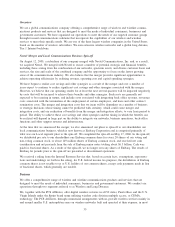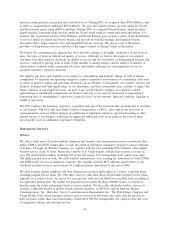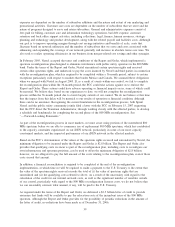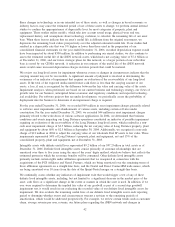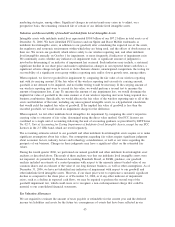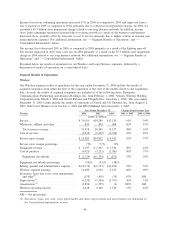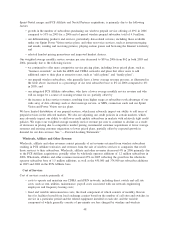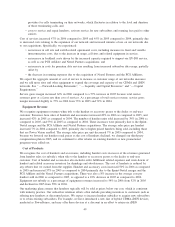Sprint - Nextel 2006 Annual Report Download - page 45
Download and view the complete annual report
Please find page 45 of the 2006 Sprint - Nextel annual report below. You can navigate through the pages in the report by either clicking on the pages listed below, or by using the keyword search tool below to find specific information within the annual report.marketing strategies, among others. Significant changes in certain trends may cause us to adjust, on a
prospective basis, the remaining estimated life of certain of our definite lived intangible assets.
Valuation and Recoverability of Goodwill and Indefinite Lived Intangible Assets
Intangible assets with indefinite useful lives represented $50.8 billion of our $97.2 billion in total assets as of
December 31, 2006. We have identified FCC licenses and our Sprint and Boost Mobile trademarks as
indefinite lived intangible assets, in addition to our goodwill, after considering the expected use of the assets,
the regulatory and economic environment within which they are being used, and the effects of obsolescence on
their use. We review our goodwill, which relates solely to our wireless reporting unit, and other indefinite
lived intangibles annually on October 1 for impairment, or more frequently if indicators of impairment exist.
We continually assess whether any indicators of impairment exist. A significant amount of judgment is
involved in determining if an indicator of impairment has occurred. Such indicators may include, a sustained,
significant decline in our share price and market capitalization, changes in our expected future cash flows, a
significant adverse change in legal factors or in the business climate, unanticipated competition, the testing for
recoverability of a significant asset group within a reporting unit, and/or slower growth rates, among others.
When required, we first test goodwill for impairment by comparing the fair value of our wireless reporting
unit with its carrying amount. If the fair value of the wireless reporting unit exceeds its carrying amount,
goodwill is not deemed to be impaired, and no further testing would be necessary. If the carrying amount of
our wireless reporting unit were to exceed its fair value, we would perform a second test to measure the
amount of impairment loss, if any. To measure the amount of any impairment loss, we would determine the
implied fair value of goodwill in the same manner as if our wireless reporting unit were being acquired in a
business combination. Specifically, we would allocate the fair value of the wireless reporting unit to all of the
assets and liabilities of that unit, including any unrecognized intangible assets, in a hypothetical calculation
that would yield the implied fair value of goodwill. If the implied fair value of goodwill is less than the
recorded goodwill, we would record an impairment charge for the difference.
When required, we test other indefinite lived intangibles for impairment by comparing the asset’s respective
carrying value to estimates of fair value, determined using the direct value method. Our FCC licenses are
combined as a single unit of accounting following the unit of accounting guidance as prescribed by EITF Issue
No. 02-7, Unit of Accounting for Testing Impairment of Indefinite-Lived Intangible Assets, except for our FCC
licenses in the 2.5 GHz band, which are tested separately.
The accounting estimates related to our goodwill and other indefinite lived intangible assets require us to make
significant assumptions about fair values. Our assumptions regarding fair values require significant judgment
about economic factors, industry factors and technology considerations, as well as our views regarding the
prospects of our business. Changes in these judgments may have a significant effect on the estimated fair
values.
During the fourth quarter 2006, we performed our annual goodwill and other indefinite lived intangible asset
analyses as described above. The result of these analyses was that our indefinite lived intangible assets were
not impaired. As permitted by Financial Accounting Standards Board, or FASB, guidance, our goodwill
analysis included an estimate of a control premium with respect to the minority interest traded value of our
common shares and an estimate of the value of our long distance business, as well as other assumptions. As of
December 31, 2006, we have not identified any indicators of impairment with respect to our goodwill and
other indefinite lived intangible assets. However, if our share price were to experience a sustained, significant
decline as compared to the share price as of December 31, 2006, or if any other indicator of impairment
exists, such as a decline in expected cash flows, we may be required to perform the second step of the
goodwill impairment test, which could cause us to recognize a non-cash impairment charge that could be
material to our consolidated financial statements.
Tax Valuation Allowances
We are required to estimate the amount of taxes payable or refundable for the current year and the deferred
income tax liabilities and assets for the future tax consequences of events that have been reflected in our
43




